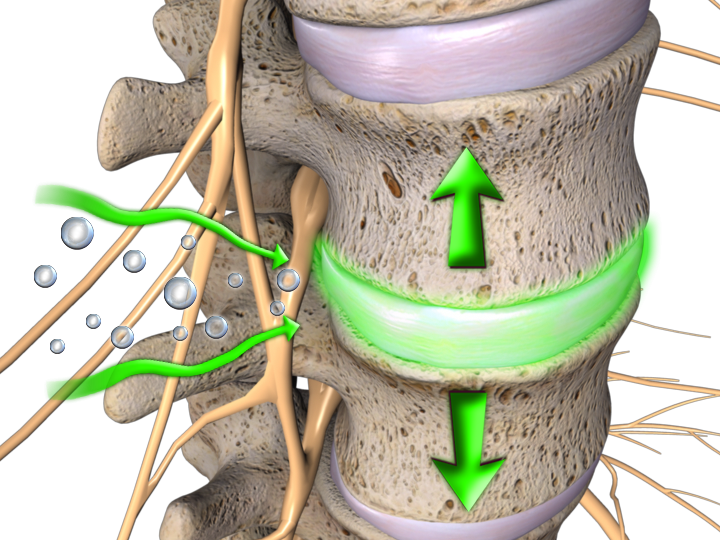Non-Surgical Spinal Decompression is a non-invasive treatment for patients who suffer from neck and back problems. A decompression treatment slowly and gently lengthens or releases pressure in the spine through repetitive movements by a customized treatment table. The table pulls and releases, creating a pressure change within the invertebral disc, surrounding soft tissue, and joints. This pressure change allows the disc bulges or herniations and nutrients to be pulled back into the disc. Rehydration of the disc and surrounding structures creates a physiological change which assists the body’s natural healing process. Patients typically experience significant improvement within 25-30 treatments. Research suggests that continued improvement is seen up to four years following decompression treatment program.
Through the logarithmic stretch and release protocols of the decompression procedure, negative pressure is created in the disc over time. This vacuum effect draws any herniated disc material back into the disc.
By reversing the effects of axial load or compression in the spine, increased circulation occurs which aids in the healing process.


After completing the lumbar decompression protocol of 30 visits using the HillDT table, there was a noticeable change in the lumbar disc height at L4/L5 vertebrae for this patient. The improvement is clearly notated by the vertical line demonstrating the increased space at the posterior margin of the disc. The patient fully recovered from all subjective complaints of lower back pain and right sciatica.
-kxe8vep8.jpg)
-v4vp5ve6.jpg)
After completing the cervical decompression protocol of 30 visits using the HillDT table, the cervical curve was restored to the normal lordosis correcting the patient’s forward head posture. An increase in the disc height can be seen from the pre to post film at the C5-C6 disc space. A significant increase in the size of the IVF of C7-T1 is noted in the post film. Decreasing the IVF encroachment or narrowing at C7-T1 reduced the numbness and pain in the patient’s neck and left arm. The patient reported a complete recovery of all symptoms after 12 weeks of care.
-kxe8vep8.jpg)
-kxe8vep8.jpg)
A 42 year old female presented in a wheel chair,unable to walk,with a history of recurrent lower back pain.She had a failed discectomy at L5-S1 from 2 years prior.After a thorough orthopaedic and neurological examination the patient was diagnosed with a L4-5 disc prolapse with severe L5 nerve root compression and concomittant right leg pain.
The patient was then placed on the Spinal Decompression Therapy program.After 5 sessions the patient no longer needed the wheel chair.The pain levels decreaed from 9 to zero in 10 sessions.She was able to walk and return to normal work duties after 16 sessions and achieved a complete recovery after 30 sessions.


It depends on the complexity and severity of the spinal condition and the rehabilitation required,however we typically treat 2 to 3 times per week for approximately 10 weeks. Each Spinal Decompression Therapy session runs for 35-40 minutes and is comprised of spinal decompression on the HillDt table,soft tissue therapy, spinal mobilisation and chiropractic adjustments. At the end of the program a schedule of rehabilitation is recommended to stabilise and strengthen the spinal and core muscles.
Spinal Decompression Therapy is one of the most gentle and comfortable forms of spinal treatment available. The state of the art spinal decompression equipment and technology has a proven safety standard and a high level of efficacy. Spinal decompression treatments have never reported to cause injury. Most patients report a mild sense of stretch on their backs, hips, necks and shoulders and often fall asleep during treatment sessions.
Designed by Doctors, Spinal Decompression Therapy with the HillDt table is an evolved and research driven treatment enhanced with the latest technology producing extraordinary and life enhancing results. Spinal Decompression Therapy has a 91% success rate with people suffering from bulging and herniated discs, spinal degeneration, chronic facet syndrome, spinal canal stenosis and failed back surgery.
Call Chiropractic One in Liverpool on (02) 9734 0044 to organise an initial consultation with our Spinal Decompression Therapy Specialist Dr Milan. You will be required to bring with you any X-rays, CT or MRI scans. After you have had a thorough spinal decompression assessment with Dr Milan and he has viewed your test results, he will let you know immediately if you are a suitable candidate for Spinal Decompression Therapy. Dr Milan is a fully certified Spinal Decompression practitioner and trainer, so you are in good hands.